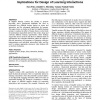Free Online Productivity Tools
i2Speak
i2Symbol
i2OCR
iTex2Img
iWeb2Print
iWeb2Shot
i2Type
iPdf2Split
iPdf2Merge
i2Bopomofo
i2Arabic
i2Style
i2Image
i2PDF
iLatex2Rtf
Sci2ools
TEI
2010
ACM
2010
ACM
Action and representation in tangible systems: implications for design of learning interactions
In tangible learning systems, the facility to promote physically active engagement highlights the need to understand how different designs impact on action and interaction, and the subsequent implications for learning. This paper draws on studies involving two tangible learning systems to analyse the effect of design choices on the kinds of (inter)actions engendered and how they create, shape and constrain different learning opportunities. Main findings suggest the need to promote and allow for different kinds of opportunities for conceptual reflection within the collective physical interaction; the importance of balancing collective representations and individual action-effect links; and the need to enhance appropriate awareness when dealing with several loci of attention. Author Keywords Tangible systems, design, action, interaction, learning opportunities. ACM Classification Keywords H5.2. Information interfaces and presentation: User interfaces. K.3.m Computers and education: Misc...
Collective Physical Interaction | Hardware | Keywords Tangible Systems | Tangible Learning Systems | TEI 2010 |
| Added | 18 May 2010 |
| Updated | 18 May 2010 |
| Type | Conference |
| Year | 2010 |
| Where | TEI |
| Authors | Sara Price, Jennifer G. Sheridan, Taciana Pontual Falcão |
Comments (0)

